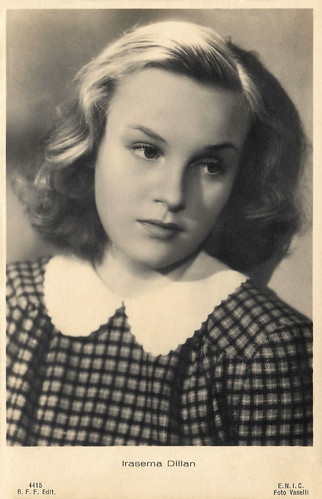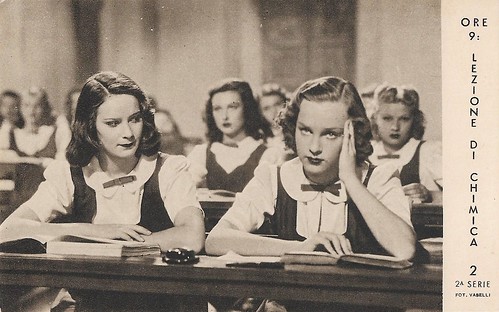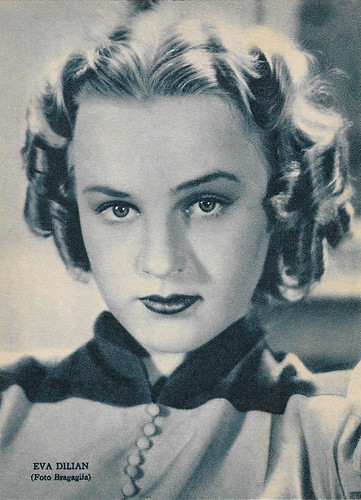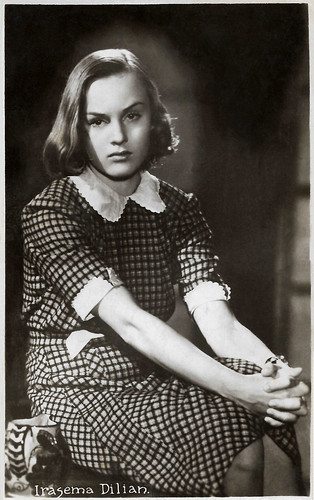Irasema Dilián or Eva Dilian (1924-1996), was a Polish-born, Italian actress. She had her breakthrough in Vittorio de Sica's Maddalena... zero in condotta/Maddalena, Zero for Conduct (1940), and became one of the most popular actresses of the Italian cinema of the 1940s. After the war, she became a star of the Mexican cinema.

Italian postcard by B.F.F. Edit, no. 2084. Photo: Venturini, Roma.

Italian postcard by B.F.F. Edit. (Casa Editrice Ballerini & Fratini, Firenze), no. 4415. Photo: Vaselli / E.N.I.C.
Irasema Dilián was born Irasema Warschalowska in 1924 in Rio de Janeiro, Brazil. She was the daughter of a Polish diplomat, who represented his country in Brazil in the 1920s. She arrived at a very young age in Rome where she enrolled in the film school Centro Sperimentale di Cinematografia, graduating in 1940.
She made her debut in a film by the French director Marcel L'Herbier, Ecco la felicità/La Comédie du bonheur/Comedy of Happiness (1940), starring Michel Simon and Ramon Novarro. Noted by director Vittorio De Sica, Dilian became one of the students in Maddalena... zero in condotta/Maddalena, Zero for Conduct (Vittorio De Sica, 1940), alongside Carla Del Poggio. From 1940, using her first pseudonym Eva Dilian, she became a hugely successful actress thanks to this role.
After Maddalena, she became the rich private schoolgirl par excellence of the Telefoni Bianchi, the Italian white telephone cinema. Dilian was certainly one of the most popular actresses of the 1940s, especially in the role of unpleasant students but at the same time endowed with beauty and sweetness. This also goes for the spoiled, snobbish merchant's daughter and failed poetess Lilli Passalacqua, who she played in Teresa Venerdì/Doctor, Beware (Vittorio De Sica, 1941), this time alongside Adriana Benetti as the protagonist.
But Irasema Dilián, her final pseudonym, found her consecration in Ore 9: lezione di chimica/Schoolgirl Diary (Mario Mattoli, 1941) alongside such young and beautiful actors as Alida Valli, Andrea Checchi and Bianca Della Corte. In the role of Maria, she was first credited in the opening titles and imposed herself on the audience as the sensitive and sincere girl that every male adolescent dreamed of marrying.
Dilián starred continuously in films that grossed a lot at the box office like Violette nei cappelli/Violets in the Hair (Carlo Ludovico Bragaglia, 1942), I sette peccati/The Seven Sins (Ladislao Kish, 1942), Malombra (Mario Soldati, 1942), and Fuga a due voci/Music on the Run (Carlo Ludovico Bragaglia, 1943), with Gino Bechi.

Italian postcard by Casa Editrice Italbore, Milano, no. 2. Photo Vaselli / Manenti Film. Alida Valli and Irasema Dilián in Ore 9: lezione di chimica/Schoolgirl Diary (Mario Mattoli, 1941).

Italian postcard by Casa Editrice Italbore, Milano, no. 9. Photo Vaselli / Manenti Film. Irasema Dilián and Alida Valli in Ore 9: lezione di chimica/Schoolgirl Diary (Mario Mattoli, 1941).

Italian postcard by Casa Editrice Italbore, Milano, no. 10. Photo Vaselli / Manenti Film. Irasema Dilián, Sandro Ruffini and Alida Valli in Ore 9: lezione di chimica/Schoolgirl Diary (Mario Mattoli, 1941).
After the war, Irasema Dilián starred in the costume films Aquila nera/The Black Eagle (Riccardo Freda, 1946) with Rossano Brazzi, La figlia del capitano/The Captain's Daughter (Mario Camerini, 1947) and Il corriere del re/The King's Courier (Gennaro Righelli, 1948), which characterised a new horizon for Dilian, who was now a woman.
During the RSI (Repubblica Sociale Italiana of Mussolini - the Republic of Salò, existing between September 1943 and May 1945), she found artistic refuge in Spain together with other Italian stars. After the war, she returned very often to the Iberian peninsula to act in four films. In 1950, Dilián married Arduino Maiuri, who became later an acclaimed screenwriter.
After the flop of the international coproduction Donne senza nome/Women Without Names (Géza von Radványi, 1950), she moved with her husband to Mexico to shoot Muchachas de Uniforme/Girls in Uniform (Alfredo B. Crevenna, 1951), an exceptional Mexican remake of the German classic Mädchen in Uniform (Leontine Sagan, Carl Froelich, 1931). This film was an extraordinary success and it catapulted Dilian towards unexpected fame in Mexico where she remained for several years.
With other actors and actresses, she created what was later called "the golden age" of Mexican cinema. In 1952, Dilián was nominated for an Ariel Award (the Mexican Oscard) for Paraíso robado/Stolen Paradise (Julio Bracho, 1951) with Arturo de Córdova. She appeared in Luis Buñuel's Abismos de pasión/Wuthering Heights (1954), but it is perhaps the only film the director regretted shooting. However, the IMDb reviewers, all rave about the film. Dilián played Caterina/Cathy opposite Jorge Mistral as Alejandro/Heathcliff.
In the late 1950s, she retired from the film business, despite being still on the crest of the wave of success. She returned to live in Italy, where her husband Arduino Maiuri continued his successful career as a screenwriter. From their marriage, two children were born, Coralla and Antonio. Irasema Dilián died in Ceprano (Frosinone) in 1996. She was 71.

Italian postcard by Rizzoli & C., Milano, 1942. Photo: Bragaglia.

Italian postcard by B.F.F. Edit. (Casa Editrice Ballerini & Fratini, Firenze), no. 44240. Photo: Vaselli / E.N.I.C.

Italian or Romanian postcard.
Sources: Wikipedia (Italian and English), and IMDb.
This post was last updated on 10 January 2024.

Italian postcard by B.F.F. Edit, no. 2084. Photo: Venturini, Roma.

Italian postcard by B.F.F. Edit. (Casa Editrice Ballerini & Fratini, Firenze), no. 4415. Photo: Vaselli / E.N.I.C.
The rich private schoolgirl par excellence
Irasema Dilián was born Irasema Warschalowska in 1924 in Rio de Janeiro, Brazil. She was the daughter of a Polish diplomat, who represented his country in Brazil in the 1920s. She arrived at a very young age in Rome where she enrolled in the film school Centro Sperimentale di Cinematografia, graduating in 1940.
She made her debut in a film by the French director Marcel L'Herbier, Ecco la felicità/La Comédie du bonheur/Comedy of Happiness (1940), starring Michel Simon and Ramon Novarro. Noted by director Vittorio De Sica, Dilian became one of the students in Maddalena... zero in condotta/Maddalena, Zero for Conduct (Vittorio De Sica, 1940), alongside Carla Del Poggio. From 1940, using her first pseudonym Eva Dilian, she became a hugely successful actress thanks to this role.
After Maddalena, she became the rich private schoolgirl par excellence of the Telefoni Bianchi, the Italian white telephone cinema. Dilian was certainly one of the most popular actresses of the 1940s, especially in the role of unpleasant students but at the same time endowed with beauty and sweetness. This also goes for the spoiled, snobbish merchant's daughter and failed poetess Lilli Passalacqua, who she played in Teresa Venerdì/Doctor, Beware (Vittorio De Sica, 1941), this time alongside Adriana Benetti as the protagonist.
But Irasema Dilián, her final pseudonym, found her consecration in Ore 9: lezione di chimica/Schoolgirl Diary (Mario Mattoli, 1941) alongside such young and beautiful actors as Alida Valli, Andrea Checchi and Bianca Della Corte. In the role of Maria, she was first credited in the opening titles and imposed herself on the audience as the sensitive and sincere girl that every male adolescent dreamed of marrying.
Dilián starred continuously in films that grossed a lot at the box office like Violette nei cappelli/Violets in the Hair (Carlo Ludovico Bragaglia, 1942), I sette peccati/The Seven Sins (Ladislao Kish, 1942), Malombra (Mario Soldati, 1942), and Fuga a due voci/Music on the Run (Carlo Ludovico Bragaglia, 1943), with Gino Bechi.

Italian postcard by Casa Editrice Italbore, Milano, no. 2. Photo Vaselli / Manenti Film. Alida Valli and Irasema Dilián in Ore 9: lezione di chimica/Schoolgirl Diary (Mario Mattoli, 1941).

Italian postcard by Casa Editrice Italbore, Milano, no. 9. Photo Vaselli / Manenti Film. Irasema Dilián and Alida Valli in Ore 9: lezione di chimica/Schoolgirl Diary (Mario Mattoli, 1941).

Italian postcard by Casa Editrice Italbore, Milano, no. 10. Photo Vaselli / Manenti Film. Irasema Dilián, Sandro Ruffini and Alida Valli in Ore 9: lezione di chimica/Schoolgirl Diary (Mario Mattoli, 1941).
Unexpected fame in Mexico
After the war, Irasema Dilián starred in the costume films Aquila nera/The Black Eagle (Riccardo Freda, 1946) with Rossano Brazzi, La figlia del capitano/The Captain's Daughter (Mario Camerini, 1947) and Il corriere del re/The King's Courier (Gennaro Righelli, 1948), which characterised a new horizon for Dilian, who was now a woman.
During the RSI (Repubblica Sociale Italiana of Mussolini - the Republic of Salò, existing between September 1943 and May 1945), she found artistic refuge in Spain together with other Italian stars. After the war, she returned very often to the Iberian peninsula to act in four films. In 1950, Dilián married Arduino Maiuri, who became later an acclaimed screenwriter.
After the flop of the international coproduction Donne senza nome/Women Without Names (Géza von Radványi, 1950), she moved with her husband to Mexico to shoot Muchachas de Uniforme/Girls in Uniform (Alfredo B. Crevenna, 1951), an exceptional Mexican remake of the German classic Mädchen in Uniform (Leontine Sagan, Carl Froelich, 1931). This film was an extraordinary success and it catapulted Dilian towards unexpected fame in Mexico where she remained for several years.
With other actors and actresses, she created what was later called "the golden age" of Mexican cinema. In 1952, Dilián was nominated for an Ariel Award (the Mexican Oscard) for Paraíso robado/Stolen Paradise (Julio Bracho, 1951) with Arturo de Córdova. She appeared in Luis Buñuel's Abismos de pasión/Wuthering Heights (1954), but it is perhaps the only film the director regretted shooting. However, the IMDb reviewers, all rave about the film. Dilián played Caterina/Cathy opposite Jorge Mistral as Alejandro/Heathcliff.
In the late 1950s, she retired from the film business, despite being still on the crest of the wave of success. She returned to live in Italy, where her husband Arduino Maiuri continued his successful career as a screenwriter. From their marriage, two children were born, Coralla and Antonio. Irasema Dilián died in Ceprano (Frosinone) in 1996. She was 71.

Italian postcard by Rizzoli & C., Milano, 1942. Photo: Bragaglia.

Italian postcard by B.F.F. Edit. (Casa Editrice Ballerini & Fratini, Firenze), no. 44240. Photo: Vaselli / E.N.I.C.

Italian or Romanian postcard.
Sources: Wikipedia (Italian and English), and IMDb.
This post was last updated on 10 January 2024.
No comments:
Post a Comment